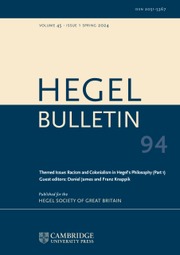Article contents
Hegel’s Treatment of Predication Considered in the Light of a Logic for the Actual World
Published online by Cambridge University Press: 06 March 2018
Abstract
One prominent feature of analytic metaphysics in the second half of the twentieth century was the revival of metaphysical debate over modality, and in this paper I suggest that a particular position that emerged within this debate, ‘modal actualism’, bears a striking resemblance to the way that Hegel discusses modal notions in the final chapter of Book 2 of the Science of Logic, ‘Wirklichkeit’ or ‘Actuality’. Modal actualists opposed David Lewis’s counter-intuitive claims about the existence of alternate possible worlds, and aimed to reconcile the reality of alternate possibilities with the common-sense idea of the actual world as all there is. Like Hegel in the chapter ‘Actuality’, they thus argue that possible alternatives to the actual world must, somehow, exist within the actual world. Here I approach these issues via the ideas of John N. Findlay who, in the 1950s, had attempted to reintroduce Hegel into an Anglophone philosophical culture, but who also influenced the later development of modal actualism via his influence on the modal logician, Arthur Prior. Like certain actualists, Findlay distinguished between two modes of predication in order to distinguish, but relate, judgements about the actual from those about the possible. This predicative dualism is strikingly similar to the way Hegel distinguishes two types of predication in his treatment of judgement in Book 3 of the Science of Logic. Reading Hegel’s dualistic account of judgement structure against this background enables us to see how it was meant to provide a logical framework for the ‘actualist’ metaphysics he earlier sketched in the chapter, ‘Actuality’.
Information
- Type
- Articles
- Information
- Copyright
- © The Hegel Society of Great Britain 2018
References
- 1
- Cited by

